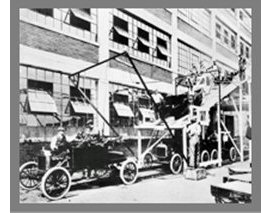Level 1 Management
 The vitality
of corporate production internationally turns on this ability to set rules and
repeat applications — from consumer product production to more esoteric concepts
such as routine business operations. Here, actions are guided by the policy manual.
You merely consult the rules and then try to fit in. The vitality
of corporate production internationally turns on this ability to set rules and
repeat applications — from consumer product production to more esoteric concepts
such as routine business operations. Here, actions are guided by the policy manual.
You merely consult the rules and then try to fit in.
In true Taylorism, people and machine become mere tools in production. The
art and science of Level 1 management includes Capacity Requirements Planning,
Time and Motion Studies, Production Control, Part Control, Inventory Control,
Material Requirements planning, Line balancing, Queuing Theory and the like.
In the Values to Rules continuum at the heart of the DBM, management prerogative
is devolved to a line supervisor. As a true Level 1 management situation. This
is a reductionist management approach — the concept is established as a set
of rules, and the supervisor is there to ensure adherence to the rules.
With that established, it is important to point out that the corollary is not
true. A Level 1 management practice entails production, but production does not
necessarily entail Level 1 management. For example, developing the product, creating
the assembly line, dealing with a situation where variation requires a rethinking
of the approach, often requires a management approach beyond Level 1.
The Henry Ford Example
 Henry Ford
is well known for his ingenuity in the production of the automobile. His purpose
was to enable mass production — establishing a rigidly defined configuration
for the automobile, one that would service the interests of the average consumer,
and one that could be readily produced in an assembly line. Buying components
in bulk, dedicating people to tasks, enabled them to become proficient in what
they do. Setting in motion the rules framework that produced many automobiles
simultaneously led to an increased yield, drove the price down, enabled greater
market penetration with the average consumer, and, thereby came close to positioning
a Ford in every driveway. Henry Ford
is well known for his ingenuity in the production of the automobile. His purpose
was to enable mass production — establishing a rigidly defined configuration
for the automobile, one that would service the interests of the average consumer,
and one that could be readily produced in an assembly line. Buying components
in bulk, dedicating people to tasks, enabled them to become proficient in what
they do. Setting in motion the rules framework that produced many automobiles
simultaneously led to an increased yield, drove the price down, enabled greater
market penetration with the average consumer, and, thereby came close to positioning
a Ford in every driveway.
The famous quote "you can have any color you want as long as it is black" epitomized
the indifference to individual consumer needs. The intent was to focus on what
the mass wanted on average from this mass production exercise, not what each particular
person wanted. Particularization was the evil that would destroy the purpose.
Rather, one set of rules and repetition under those drove efficiency and a huge
success. Black was also the fastest drying paint, which further enabled efficiency
in the production schedule.
Today, the automotive industry operates much the same way — perhaps with variants in models and options to enable some consumer choice. You can order the A package, the B package, the C package. You can have the standard model or the deluxe model and, in addition, you can now have colors!
|



